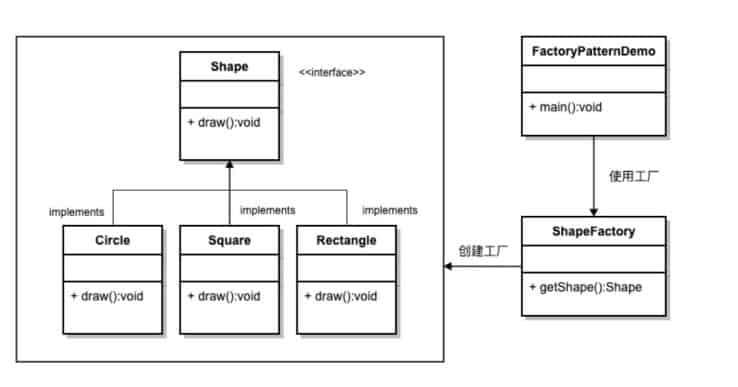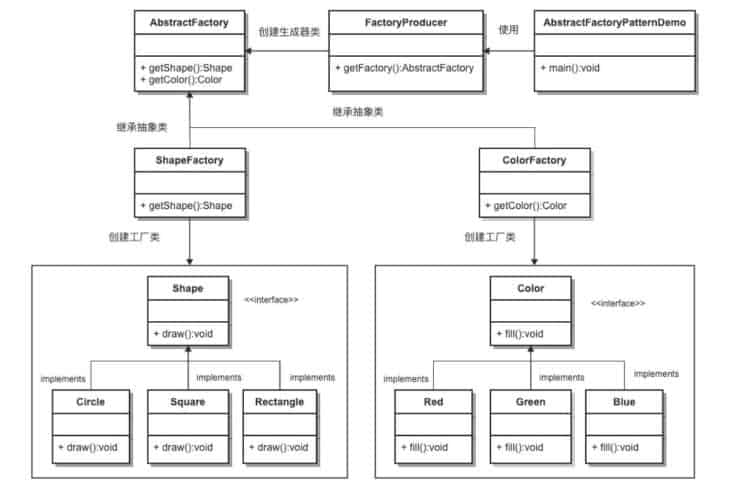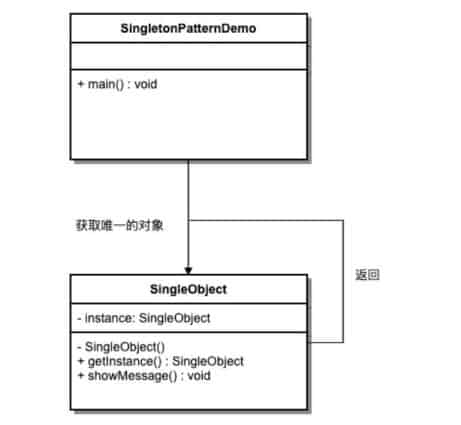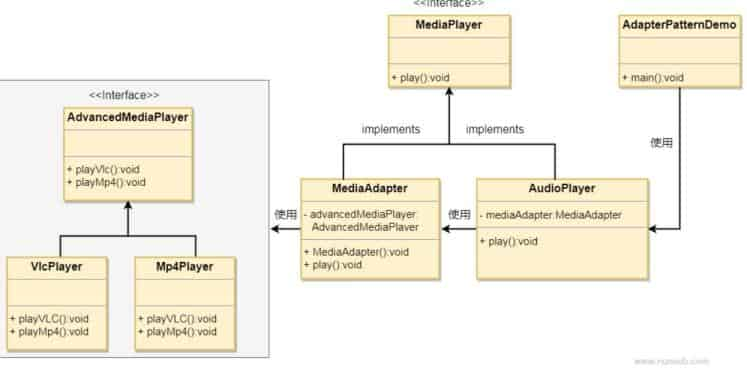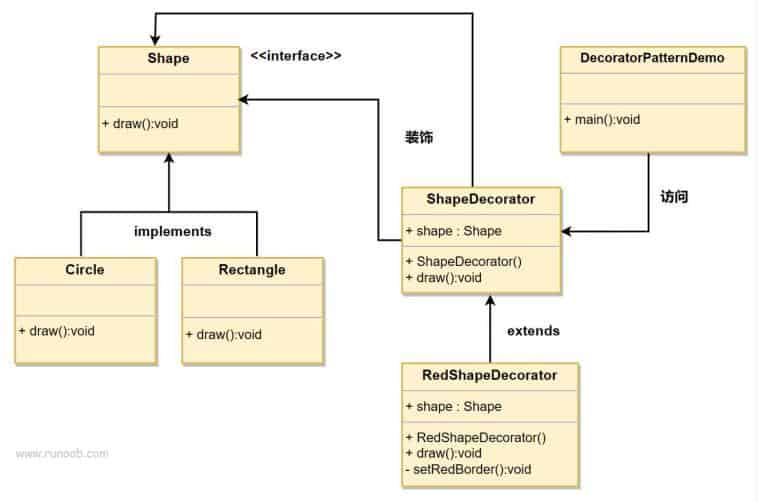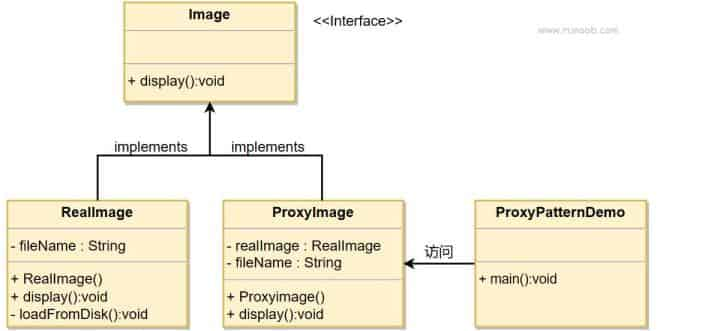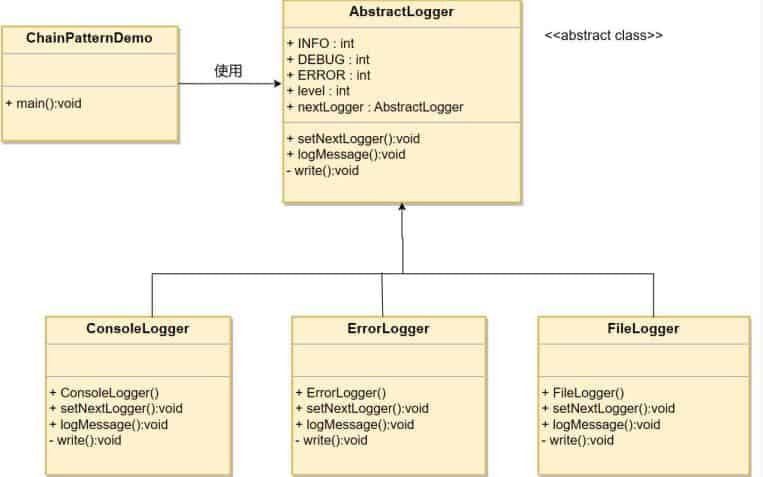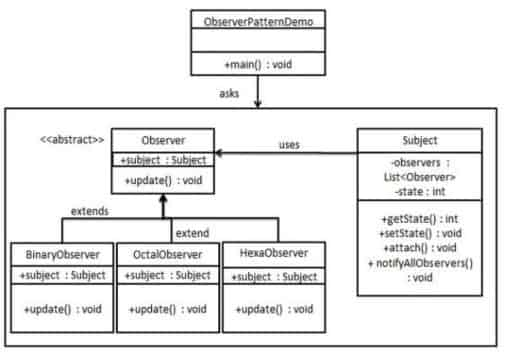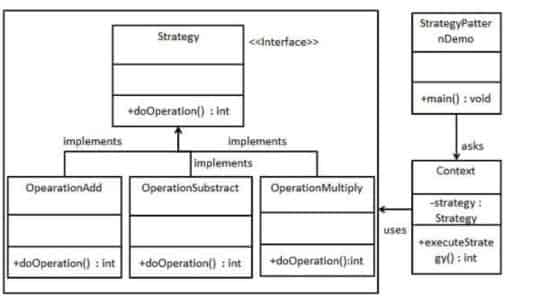设计模式期末复习(java) 简单工厂 uml类图
优点: 1.使用工厂方法可以让用户的代码和某个特定类的子类的代
缺点 1.不符合开闭原则
代码 1 2 3 4 5 6 7 8 9 10 11 12 13 14 15 16 17 18 19 20 21 22 23 24 25 26 27 28 29 30 31 32 33 34 35 36 37 38 39 40 41 42 43 44 45 46 47 48 49 50 51 52 53 54 55 56 57 58 59 60 61 62 63 64 65 66 67 68 69 public interface Shape { void draw () ; } public class Rectangle implements Shape { @Override public void draw () { System.out.println("Inside Rectangle::draw() method." ); } } public class Square implements Shape { @Override public void draw () { System.out.println("Inside Square::draw() method." ); } } public class Circle implements Shape { @Override public void draw () { System.out.println("Inside Circle::draw() method." ); } } public class ShapeFactory { public Shape getShape (String shapeType) { if (shapeType == null ){ return null ; } if (shapeType.equalsIgnoreCase("CIRCLE" )){ return new Circle (); } else if (shapeType.equalsIgnoreCase("RECTANGLE" )){ return new Rectangle (); } else if (shapeType.equalsIgnoreCase("SQUARE" )){ return new Square (); } return null ; } } public class FactoryPatternDemo { public static void main (String[] args) { ShapeFactory shapeFactory = new ShapeFactory (); Shape shape1 = shapeFactory.getShape("CIRCLE" ); shape1.draw(); Shape shape2 = shapeFactory.getShape("RECTANGLE" ); shape2.draw(); Shape shape3 = shapeFactory.getShape("SQUARE" ); shape3.draw(); } }
抽象工厂 uml类图
优点: 1.抽象工厂模式可以为用户创建一系列相关的对象,使得用
2.使用抽象工厂模式可以方便的为用户配置一系列对象。用
3.在抽象工厂模式中,面对新的“具体产品” ,可以随时
缺点 1.不符合开闭原则:当需要新增一种产品时,除了需要添加新的具体产品类,还需要修改抽象工厂的接口和所有具体工厂的实现类,违背了开闭原则。
2.增加了系统的复杂性:引入抽象工厂模式会增加类的数量,增加了系统的复杂性和理解难度。
3.不易扩展新的产品族:抽象工厂模式适用于一系列相互依赖的产品对象的创建,但当需要增加新的产品族时,需要修改抽象工厂接口及其所有具体工厂的实现类,不易扩展新的产品族。
代码 1 2 3 4 5 6 7 8 9 10 11 12 13 14 15 16 17 18 19 20 21 22 23 24 25 26 27 28 29 30 31 32 33 34 35 36 37 38 39 40 41 42 43 44 45 46 47 48 49 50 51 52 53 54 55 56 57 58 59 60 61 62 63 64 65 66 67 68 69 70 71 72 73 74 75 76 77 78 79 80 81 82 83 84 85 86 87 88 89 90 91 92 93 94 95 96 97 98 99 100 101 102 103 104 105 106 107 108 109 110 111 112 113 114 115 116 117 118 119 120 121 122 123 124 125 126 127 128 129 130 131 132 133 134 135 136 137 138 139 140 141 142 143 144 145 146 147 148 149 150 151 152 153 154 155 156 157 158 159 160 161 162 163 164 165 166 167 168 169 170 171 172 173 public interface Shape { void draw () ; } public class Rectangle implements Shape { @Override public void draw () { System.out.println("Inside Rectangle::draw() method." ); } } public class Square implements Shape { @Override public void draw () { System.out.println("Inside Square::draw() method." ); } } public class Circle implements Shape { @Override public void draw () { System.out.println("Inside Circle::draw() method." ); } } public interface Color { void fill () ; } public class Red implements Color { @Override public void fill () { System.out.println("Inside Red::fill() method." ); } } public class Green implements Color { @Override public void fill () { System.out.println("Inside Green::fill() method." ); } } public class Blue implements Color { @Override public void fill () { System.out.println("Inside Blue::fill() method." ); } } public abstract class AbstractFactory { public abstract Color getColor (String color) ; public abstract Shape getShape (String shape) ; } public class ShapeFactory extends AbstractFactory { @Override public Shape getShape (String shapeType) { if (shapeType == null ){ return null ; } if (shapeType.equalsIgnoreCase("CIRCLE" )){ return new Circle (); } else if (shapeType.equalsIgnoreCase("RECTANGLE" )){ return new Rectangle (); } else if (shapeType.equalsIgnoreCase("SQUARE" )){ return new Square (); } return null ; } @Override public Color getColor (String color) { return null ; } } public class ColorFactory extends AbstractFactory { @Override public Shape getShape (String shapeType) { return null ; } @Override public Color getColor (String color) { if (color == null ){ return null ; } if (color.equalsIgnoreCase("RED" )){ return new Red (); } else if (color.equalsIgnoreCase("GREEN" )){ return new Green (); } else if (color.equalsIgnoreCase("BLUE" )){ return new Blue (); } return null ; } } FactoryProducer.java public class FactoryProducer { public static AbstractFactory getFactory (String choice) { if (choice.equalsIgnoreCase("SHAPE" )){ return new ShapeFactory (); } else if (choice.equalsIgnoreCase("COLOR" )){ return new ColorFactory (); } return null ; } } AbstractFactoryPatternDemo.java public class AbstractFactoryPatternDemo { public static void main (String[] args) { AbstractFactory shapeFactory = FactoryProducer.getFactory("SHAPE" ); Shape shape1 = shapeFactory.getShape("CIRCLE" ); shape1.draw(); Shape shape2 = shapeFactory.getShape("RECTANGLE" ); shape2.draw(); Shape shape3 = shapeFactory.getShape("SQUARE" ); shape3.draw(); AbstractFactory colorFactory = FactoryProducer.getFactory("COLOR" ); Color color1 = colorFactory.getColor("RED" ); color1.fill(); Color color2 = colorFactory.getColor("GREEN" ); color2.fill(); Color color3 = colorFactory.getColor("BLUE" ); color3.fill(); } }
单例模式(优缺点) uml类图
优点: 系统内存中该类只存在一个对象,节省了系统资源,对于一些需要
缺点 当想实例化一个单例类的时候,必须要记住使用相应的获取对象的
代码 饿汉
1 2 3 4 5 6 7 8 9 10 public class EHan { private static EHan eh = new EHan (); private EHan () { } public static EHan init () { return eh; } }
1 2 3 4 5 6 7 8 9 10 11 public class LanHan { private static LanHan lh; private LanHan () {} public static LanHan init () { if (lh == null ) { lh = new LanHan (); } return lh; } }
1 2 3 4 5 6 7 8 9 10 11 12 13 14 15 public class LanHan { private static volatile LanHan lh; private LanHan () {} public static LanHan init () { if (lh == null ) { synchronized (LanHan.class) { if (lh == null ) { lh = new LanHan (); } } } return lh; } },
1 2 3 4 5 6 7 8 9 10 public class Wai { private Wai () {} private static class Nei { private static final Wai wai = new Wai (); } public static Wai init () { return Nei.wai; } }
适配器模式 uml类图
优点: 1.目标( Target )和被适配者( Adaptee )是完
2.适配器模式满足“开 - 闭原则”。当添加一个
缺点 1、过多地使用适配器,会让系统非常零乱,不易整体进行把握。比如,明明看到调用的是 A 接口,其实内部被适配成了 B 接口的实现,一个系统如果太多出现这种情况,无异于一场灾难。因此如果不是很有必要,可以不使用适配器,而是直接对系统进行重构。 2.由于 JAVA 至多继承一个类,所以至多只能适配一个适配者类,而且目标类必须是抽象类。
装饰器模式 uml类图
优点: 1.被装饰者和装饰者是松耦合关系。由于装饰( Decorator )仅仅依
2.装饰模式满足“开 - 闭原则”。不必修改具体组件,就可以增加新
3.可以使用多个具体装饰来装饰具体组件的实例。
4.装饰者模式是继承的有力补充,且比继承灵活,可以在不改变原有对象
缺点 1.增加了系统复杂性:引入适配器类增加了系统的复杂性,因为需要额外的类来实现适配器功能。
2.可能存在性能损失:适配器模式在转换接口的过程中可能需要进行额外的处理和转换,这可能导致一定的性能损失。
3.不适用于过多的适配器:如果系统中存在大量的适配器类,可能会导致代码混乱和难以维护。
代码 家案例 接口
1 2 3 4 5 public interface Component { StringBuffer show (StringBuffer str) ; }
1 2 3 4 5 6 7 8 9 10 11 public class MyNewHouse implements Component { private String name; public MyNewHouse (String name) { this .name=name; } @Override public StringBuffer show (StringBuffer str) { return str.append( "this is" +name+"home where has:" ); } }
1 2 3 4 5 6 7 8 9 10 11 12 13 14 15 public class Furniture implements Component { private Component com; public Furniture (Component com) { this .com=com; } @Override public StringBuffer show (StringBuffer str) { if (com!=null ) { return com.show(str); }else { return null ; } } }
1 2 3 4 5 6 7 8 9 10 11 12 13 public class BingXiang extends ZhuangShi { public BingXiang (Component com) { super (com); } @Override public StringBuffer show (StringBuffer str) { super .show(str); return str.append("bingxiang" ); } }
1 2 3 4 5 6 7 8 9 10 11 12 13 public class ShaFa extends Furniture { public ShaFa (Component com) { super (com); } @Override public StringBuffer show (StringBuffer str) { super .show(str); return str.append(" shafa" ); } }
1 2 3 4 5 6 7 8 9 10 11 12 public class TV extends Furniture { public TV (Component com) { super (com); } @Override public StringBuffer show (StringBuffer str) { super .show(str); return str.append("tv" ); } }
1 2 3 4 5 6 7 8 9 10 public class Test { public static void main (String[] args) { MyNewHouse mnh=new MyNewHouse ("zhangsan" ); TV tv=new TV (mnh); ShaFa sf=new ShaFa (tv); BingXiang bx=new BingXiang (sf); System.out.println(bx.show(new StringBuffer ())); } }
鸟案例 1 2 3 4 5 6 7 8 9 10 11 12 13 14 15 16 17 18 19 20 21 22 23 24 25 26 27 28 29 30 31 32 33 34 35 36 37 38 39 40 41 42 43 44 45 46 47 48 49 50 51 52 53 54 55 56 57 58 59 60 61 62 63 64 65 66 67 68 public abstract class Bird { public abstract int fly () ; } public class HuoJian extends JiNeng { public final int distance=1000 ; public HuoJian (Bird bird) { super (bird); } @Override public int fly () { return bird.fly()+distance; } public int juli () { System.out.println("" +distance+"��" ); return distance; } } public abstract class JiNeng extends Bird { public Bird bird; public JiNeng (Bird bird) { this .bird=bird; } } public class LuoXuanJiang extends JiNeng { public final int distance=50 ; public LuoXuanJiang (Bird bird) { super (bird); } @Override public int fly () { return bird.fly()+distance; } public int juli () { System.out.println("����������������ǰ����" +distance+"��" ); return distance; } } public class MaQue extends Bird { public final int distance=100 ; @Override public int fly () { return distance; } } public class Test { public static void main (String[] args) { Bird bird=new MaQue (); System.out.println("��ֻ����Է��У�" +bird.fly()); System.out.println("-------------------" ); LuoXuanJiang b1=new LuoXuanJiang (bird); b1.juli(); System.out.println("��ֻ����Է��У�" +b1.fly()); System.out.println("-------------------" ); LuoXuanJiang b2=new LuoXuanJiang (b1); b2.juli(); System.out.println("��ֻ����Է��У�" +b2.fly()); System.out.println("-------------------" ); HuoJian b3=new HuoJian (b2); b3.juli(); System.out.println("��ֻ����Է��У�" +b3.fly()); System.out.println("-------------------" ); } }
组装电脑 1 2 3 4 5 6 7 8 9 10 11 12 13 14 15 16 17 18 19 20 21 22 23 24 25 26 27 28 29 30 31 32 33 34 35 36 37 38 39 40 41 42 43 44 45 46 47 48 49 50 51 52 53 54 55 56 57 58 59 60 61 62 63 64 65 66 67 68 69 70 71 72 public abstract class AbstractComputer { public abstract String getMsg () ; public abstract int getPrice () ; } public class BaseComputer extends AbstractComputer { @Override public String getMsg () { return "电脑" ; } @Override public int getPrice () { return 5000 ; } } public class NeiCun extends ZhuangShi { public NeiCun (AbstractComputer com) { super (com); } @Override public String getMsg () { return super .getMsg()+"+1个内存" ; } @Override public int getPrice () { return super .getPrice()+500 ; } } public class YingPan extends ZhuangShi { public YingPan (AbstractComputer com) { super (com); } @Override public String getMsg () { return super .getMsg()+"+1个硬盘" ; } @Override public int getPrice () { return super .getPrice()+1000 ; } } public class ZhuangShi extends AbstractComputer { private AbstractComputer com; public ZhuangShi (AbstractComputer com) { this .com=com; } @Override public String getMsg () { return com.getMsg(); } @Override public int getPrice () { return com.getPrice(); } } public class Test { public static void main (String[] args) { AbstractComputer com=new BaseComputer (); com=new NeiCun (com); com=new YingPan (com); com=new NeiCun (com); System.out.println(com.getMsg()+"价格" +com.getPrice()); } }
代理模式 uml类图
优点: 1.代理模式可以屏蔽用户真正请求的对象,使用户程序和
缺点 1、由于在客户端和真实主题之间增加了代理对象,因此有些类型的代理模式可能会造成请求的处理速度变慢。 2、实现代理模式需要额外的工作,有些代理模式的实现非常复杂。
代码 静态代理 挖掘机案例
1 2 3 4 5 6 7 8 9 10 11 12 13 14 15 16 17 18 19 20 21 22 23 24 25 26 27 28 29 30 31 32 33 34 35 36 37 38 39 40 41 42 43 44 45 46 47 public interface RenWu { public void waTu () ; public void caoCai () ; } public class User implements RenWu { @Override public void waTu () { System.out.println("工人使用挖掘机挖土" ); } @Override public void caoCai () { System.out.println("工人使用挖掘机炒菜" ); } } public class DaiLiStatic implements RenWu { private RenWu work; public DaiLiStatic (RenWu work) { this .work=work; } @Override public void waTu () { System.out.println("劳务中心抽取费用" ); work.waTu(); } @Override public void caoCai () { System.out.println("劳务中心抽取费用" ); work.caoCai(); } } public class Test { public static void main (String[] args) { User user=new User (); DaiLiStatic dl=new DaiLiStatic (user); dl.waTu(); dl.caoCai(); } }
登录案例
1 2 3 4 5 6 7 8 9 10 11 12 13 14 15 16 17 18 19 20 21 22 23 24 25 26 27 28 29 30 31 32 33 34 35 36 37 38 39 40 41 42 43 44 45 46 public interface UserDao { public void doLogin () ; public void doRegister () ; } public class UserDaoImpl implements UserDao { @Override public void doLogin () { System.out.println("ִ执行登录" ); } @Override public void doRegister () { System.out.println("ִ执行注册" ); } } public class StaticUser implements UserDao { private UserDao dao; public StaticUser (UserDao dao) { this .dao=dao; } @Override public void doLogin () { System.out.println("代理机构抽取佣金" ); dao.doLogin(); } @Override public void doRegister () { System.out.println("代理机构抽取佣金" ); dao.doRegister(); } } public class Test { public static void main (String[] args) { UserDao dao=new UserDaoImpl (); StaticUser dl=new StaticUser (dao); dl.doLogin(); dl.doRegister(); } }
动态代理 1 2 3 4 5 6 7 8 9 10 11 12 13 14 15 16 17 18 19 20 21 22 23 24 25 26 27 28 29 30 31 32 33 34 35 36 37 38 39 40 41 42 43 44 45 46 47 interface Calculator { int add (int a, int b) ; } class CalculatorImpl implements Calculator { @Override public int add (int a, int b) { return a + b; } } class CalculatorProxy implements InvocationHandler { private final Object target; public CalculatorProxy (Object target) { this .target = target; } @Override public Object invoke (Object proxy, Method method, Object[] args) throws Throwable { System.out.println("Before method invocation" ); Object result = method.invoke(target, args); System.out.println("After method invocation" ); return result; } } public class DynamicProxyExample { public static void main (String[] args) { Calculator calculator = new CalculatorImpl (); Calculator proxy = (Calculator) Proxy.newProxyInstance( Calculator.class.getClassLoader(), new Class []{Calculator.class}, new CalculatorProxy (calculator) ); int result = proxy.add(2 , 3 ); System.out.println("Result: " + result); } }
责任链模式 uml类图
优点: 1、降低耦合度。它将请求的发送者和接收者解耦。 2、简化了对象。使得对象不需要知道链的结构。 3、增强给对象指派职责的灵活性。通过改变链内的成员或者调动它们的次序,允许动态地新增或者删除责任。 4、增加新的请求处理类很方便。
缺点 1、不能保证请求一定被接收。 2、系统性能将受到一定影响,而且在进行代码调试时不太方便,可能会造成循环调用。 3、可能不容易观察运行时的特征,有碍于除错。
代码 1 2 3 4 5 6 7 8 9 10 11 12 13 14 15 16 17 18 19 20 21 22 23 24 25 26 27 28 29 30 31 32 33 34 35 36 37 38 39 40 41 42 43 44 45 46 47 48 49 50 51 52 53 54 public interface MyFilter { public String doFilter (String name) ; } public class FaceFilter implements MyFilter { @Override public String doFilter (String name) { String tmp=name.replace("(:)" , "!!" ); System.out.println("经过表情包过滤" ); return tmp; } } public class MsgFilter implements MyFilter { @Override public String doFilter (String name) { String tmp=name.replace("敏感" , "**" ); System.out.println("经过表情包过滤" ); return tmp; } } public class MyFilterChain implements MyFilter { private Set<MyFilter> filters=new HashSet <MyFilter>(); public MyFilterChain addFilter (MyFilter filter) { this .filters.add(filter); return this ; } @Override public String doFilter (String name) { String tmp=name; for (MyFilter filter:filters) { tmp=filter.doFilter(tmp); } return tmp; } } public class Test { public static void main (String[] args) { String str="大家敏感好(:)天气不错,铭感风有点大(:)(:),哈哈" ; MyFilterChain chain = new MyFilterChain (); chain.addFilter(new FaceFilter ()).addFilter(new MsgFilter ()); String result=chain.doFilter(str); System.out.println(result); } }
观察者模式 uml类图
优点: 1.具体主题和具体观察者是松耦合关系。由于主题( Subject )接口仅仅依
2.观察模式满足“开 - 闭原则”。主题( Subject )接口仅仅依赖于观察者
缺点 1、如果一个被观察者对象有很多的直接和间接的观察者的话,将所有的观察者都通知到会花费很多时间。 2、如果在观察者和观察目标之间有循环依赖的话,观察目标会触发它们之间进行循环调用,可能导致系统崩溃。 3、观察者模式没有相应的机制让观察者知道所观察的目标对象是怎么发生变化的,而仅仅只是知道观察目标发生了变化。
策略模式 uml类图
优点: 1.上下文( Context )和具体策略( ConcreteStrategy )是松耦合关系。
缺点 1、策略类会增多。 2、所有策略类都需要对外暴露。
代码 1 2 3 4 5 6 7 8 9 10 11 12 13 14 15 16 17 18 19 20 21 22 23 24 25 26 27 28 29 30 31 32 33 34 35 36 37 38 39 40 41 42 43 44 45 46 47 48 49 50 51 52 53 54 55 56 57 58 59 60 61 62 63 64 65 66 67 68 69 70 71 72 73 import java.util.ArrayList;import java.util.List;interface Subject { void attach (Observer observer) ; void detach (Observer observer) ; void notifyObservers (String message) ; } class ConcreteSubject implements Subject { private List<Observer> observers = new ArrayList <>(); @Override public void attach (Observer observer) { observers.add(observer); } @Override public void detach (Observer observer) { observers.remove(observer); } @Override public void notifyObservers (String message) { for (Observer observer : observers) { observer.update(message); } } } interface Observer { void update (String message) ; } class ConcreteObserver implements Observer { private String name; public ConcreteObserver (String name) { this .name = name; } @Override public void update (String message) { System.out.println(name + " 收到消息: " + message); } } public class ObserverExample { public static void main (String[] args) { ConcreteSubject subject = new ConcreteSubject (); Observer observer1 = new ConcreteObserver ("观察者1" ); Observer observer2 = new ConcreteObserver ("观察者2" ); subject.attach(observer1); subject.attach(observer2); subject.notifyObservers("你好,世界!" ); subject.detach(observer1); subject.notifyObservers("观察者1已分离!" ); } }
打折案例
1 2 3 4 5 6 7 8 9 10 11 12 13 14 15 16 17 18 19 20 21 22 23 24 25 26 27 28 29 30 31 32 33 34 35 36 37 38 39 40 41 42 43 44 45 46 47 48 49 50 51 public interface JiSuan { public double jiSuanPrice (double price,int n) ; } public class PuTong implements JiSuan { @Override public double jiSuanPrice (double price, int n) { return price*n; } } public class ZhongJi implements JiSuan { @Override public double jiSuanPrice (double price, int n) { return price*n*0.9 ; } } public class GaoJi implements JiSuan { @Override public double jiSuanPrice (double price, int n) { return price*n*0.8 ; } } public class MyContext { private JiSuan jisuan; public MyContext (JiSuan jisuan) { this .jisuan=jisuan; } public double showPice (double price,int n) { return jisuan.jiSuanPrice(price, n); } } public class Test { public static void main (String[] args) { MyContext c1=new MyContext (new PuTong ()); MyContext c2=new MyContext (new GaoJi ()); MyContext c3=new MyContext (new ZhongJi ()); System.out.println("pt" +c1.showPice(300 , 1 )); System.out.println("zj" +c3.showPice(300 , 1 )); System.out.println("gj" +c2.showPice(300 , 1 )); } }
1 2 3 4 5 6 7 8 9 10 11 12 13 14 15 16 17 18 19 20 21 22 23 24 25 26 27 28 29 30 31 32 33 34 35 36 37 38 39 40 41 42 43 44 45 46 47 48 49 50 51 52 53 54 55 56 57 58 59 60 61 62 63 64 65 66 67 public interface CeLuo { public String getQu () ; public String getDo () ; } public class ZouLu implements CeLuo { @Override public String getQu () { return "走路" ; } @Override public String getDo () { return "还书" ; } } public class QiChe implements CeLuo { @Override public String getQu () { return "骑车" ; } @Override public String getDo () { return "看书" ; } } public class KaiChe implements CeLuo { @Override public String getQu () { return "开车" ; } @Override public String getDo () { return "paoniu" ; } } public class MyContext { private CeLuo cl; public MyContext (CeLuo cl) { this .cl=cl; } public String toDo () { return cl.getQu()+"ȥ" +cl.getDo(); } } public class Test { public static void main (String[] args) { MyContext m1=new MyContext (new ZouLu ()); System.out.println(m1.toDo()); MyContext m2=new MyContext (new QiChe ()); System.out.println(m2.toDo()); MyContext m3=new MyContext (new KaiChe ()); System.out.println(m3.toDo()); } }
设计模式分类 创建型模式,共四种:
